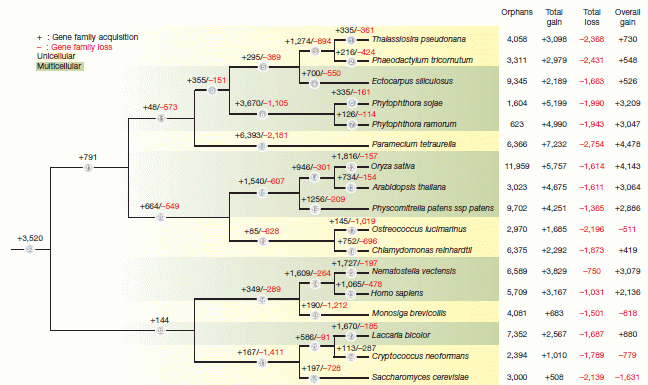The Independent Evolution of MulticellularityDarwinists often claim a) that standard darwinian theory provides the basis on which virtually all modern evolutionary research is conducted, and b) that most of this research positively corroborates the theory. A recent article by an international team of 77 scientists, titled "The Ectocarpus genome and the independent evolution of multicellularity in brown algae" (1), should be an instance of such research. Accepting a), let's have a close look to see how well the article supports b), the claim that research corroborates darwinism. The article reports on the genome of the filamentous seaweed Ectocarpus siliculosus (Dillwyn) Lyngbye, with 16,256 protein coding genes. "These seaweeds are the dominant species in rocky coastal ecosystems and they exhibit many interesting adaptations to these, often harsh, environments. Brown algae are also one of only a small number of eukaryotic lineages that have evolved complex multicellularity." Great, the words "adaptations" and "evolved" make it sound like we are in for some corroboration. In common parlance, adaptations are evolutionary changes that occur over multiple generations in response to environmental changes. And the evolution of a new feature like multicellularity requires the acquisition of new genetic programs which, in standard darwinian theory, were originally composed from unrelated programs or random strands, by long trial and error. But the words appear to mean something else when scrutinized in this article. The abstract continues, "the presence of an extended set of light-harvesting and pigment biosynthesis genes and new metabolic processes such as halide metabolism help explain the ability of this organism to cope with the highly variable tidal environment." Yes, but these abilities were earlier described as adaptations. Now the genes are simply there, with no suggestion of any changes that took place over multiple generations. Apparently, this misleading sense of adaptation is sometimes the operative one: "Ectocarpus has a complex photosynthetic system that should enable it to adapt to an environment with highly variable light conditions." It already has the system. Elsewhere, adaptation may signify the process we expected: "The diverse complement of enzymes involved in the metabolism of reactive oxygen species ...is also likely to represent an important adaptation to osmotic and light stresses." Okay, but if this took place over multiple generations, where's the evidence for that process? All we learn here is that this species has a feature its ancestors apparently didn't. Furthermore, "The evolution of multicellularity in this lineage is correlated with the presence of a rich array of signal transduction genes." Fine, but evolution is a process, and the presence of genes says nothing about any process. The process is simply assumed to have occurred. This error is soon repeated: "Several features of the Ectocarpus genome indicate that this alga has evolved effective mechanisms for survival in this environment." The sentence is certifiably true only if for "evolved" one substitutes "acquired." The authors hardly notice their assumption. "Analysis of the Ectocarpus genome failed to detect homologues of many of the enzymes that are known, from other organisms, to have roles in alginate biosynthesis and in the remodelling of alginates, fucans and cellulose, indicating that brown algae have independently evolved enzymes to carry out many of these processes." Here they don't even identify the new enzymes, but they must exist, therefore they must have "evolved." However, when they quantify the genes needed for specific new features, in a figure legend, their language becomes more realistic: Now the new genes have been "acquired... gained or lost." And in a separate comment they notice that the genome contains genes installed by a DNA virus, and "...almost all ...were silent."
Another segment of the research report was especially noteworthy to us: "The Ectocarpus genome contains a number of other genes that could have potentially had important roles in the development of multicellularity.... For example there are several additional membrane-localized proteins of interest, including three integrin-related proteins. Integrins have an important role in cell adhesion in animals but integrin genes are absent from all the previously sequenced stramenopile genomes." This absence actually counts against the standard darwinian acount of new genes composed by long trial and error. If the genes had evolved the darwinian way, there should be identifiable precursors in related species (2). All of this is not merely nit-picking about evolution. The details of the process are important. Closed-system tests in biological or computer models do not corroborate the darwinian account for new genetic programs (3,4). The research described here, a reconstruction of events based on genomics, also doesn't corroborate the darwinian account. And this research report is not unusual. We think the lack of firm supporting evidence is actually a crisis for standard darwinism. That's why we believe that alternatives like cosmic ancestry deserve consideration.
| ||
